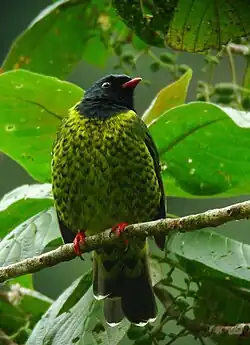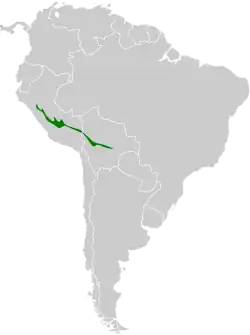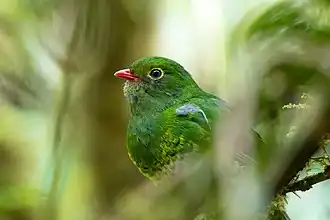Band-tailed fruiteater
| Band-tailed fruiteater | |
|---|---|

| |
| Male | |
| Scientific classification | |
| Kingdom: | Animalia |
| Phylum: | Chordata |
| Class: | Aves |
| Order: | Passeriformes |
| Family: | Cotingidae |
| Genus: | Pipreola |
| Species: | P. intermedia
|
| Binomial name | |
| Pipreola intermedia Taczanowski, 1884
| |

| |
The band-tailed fruiteater (Pipreola intermedia) is a species of bird in the family Cotingidae, the cotingas. It is found in Bolivia and Peru.[2]
Taxonomy and systematics
The band-tailed fruiteater was originally described as Pipreola viridis intermedia, a subspecies of the green-and-black fruiteater (later P. riefferii).[3] Since the early twentieth century it has been treated as a full species.[4]
The band-tailed fruiteater has two subspecies, the nominate P. i. intermedia (Taczanowski, 1884) and P. i. signata (Carl Eduard Hellmayr, 1917).[2]

Description
The band-tailed fruiteater is 18.5 to 19.5 cm (7.3 to 7.7 in) long and weighs 44 to 59 g (1.6 to 2.1 oz). The sexes have different plumage. Adult males of the nominate subspecies have an entirely black head and upper breast with a thin yellow band ("collar") around its base except on the nape. Their upperparts are green and the wings and tail mostly that color. The wing's tertials have white tips. The tail has a black bar near the end and white tips on the feathers. Their underparts are yellow with black scallops. Their flanks are green and also have black scallops. Females have a green head instead of the male's black, little or no yellow collar, and less black scalloping on the underparts. They have a yellow eye-ring. Both sexes have a brown iris, a crimson bill with sometimes a black culmen, and red or orange-red legs and feet. Subspecies P. i. signata has a much bolder yellow collar than the nominate and brighter yellow, mostly unmarked, underparts. The band-tailed fruiteater is very similar to the green-and-black fruiteater with whose range it overlaps, but that species is smaller and does not have the black tail band.[5][6]
Distribution and habitat
The nominate subspecies of the band-tailed fruiteater is the more northerly of the two. It is found along the eastern slope of the Andes of Peru from La Libertad and San Martín departments south to Junín Department. Subspecies P. i. signata is found along the eastern slope from Cuzco and Puno departments in Peru south into Bolivia's La Paz and Cochabamba departments. It inhabits the interior and edges of montane forest in the temperate zone. In elevation it ranges mostly between 2,100 and 3,000 m (6,900 and 9,800 ft) in Peru but down to 1,500 m (4,900 ft) in the south. In Bolivia it ranges between 1,100 and 2,800 m (3,600 and 9,200 ft).[5][6]
Behavior
Movement
The band-tailed fruiteater is a year-round resident, though some elevational movement is suspected in Biolivia.[5]
Feeding
The band-tailed fruiteater is believed to feed only on fruit but details are lacking.[5]
Breeding
Nothing is known about the band-tailed fruiteater's breeding biology.[5]
Vocalization
The band-tailed fruiteater's song is "a series of very high notes followed by [a] thin, descending whistle, ti-ti-ti teeeeeeew" and its call "a series of high ti or tswee notes".[6]
Status
The IUCN has assessed the band-tailed fruiteater as being of Least Concern. It has large range; its population size is not known and is believed to be decreasing. No immediate threats have been identified.[1] It is considered "fairly common and widespread" in Peru.[6] It occurs in at least one national park in each of Peru and Bolivia.[5]
References
- ^ a b BirdLife International (2024). "Band-tailed Fruiteater Pipreola intermedia". IUCN Red List of Threatened Species. 2024: e.T22700785A264372784. doi:10.2305/IUCN.UK.2024-2.RLTS.T22700785A264372784.en. Retrieved 19 August 2025.
- ^ a b Gill, Frank; Donsker, David; Rasmussen, Pamela, eds. (March 2025). "Cotingas, manakins, tityras, becards". IOC World Bird List. v 15.1. Retrieved 3 March 2025.
- ^ Taczanowski, Władysław (1884). Ornithologie du Pérou (in Latin and French). Vol. 2. Typographie Oberthur. pp. 376–377. Retrieved August 19, 2025.
- ^ Remsen, J. V., Jr., J. I. Areta, E. Bonaccorso, S. Claramunt, G. Del-Rio, A. Jaramillo, D. F. Lane, M. B. Robbins, F. G. Stiles, and K. J. Zimmer. Version 31 July 2025. A classification of the bird species of South America. American Ornithological Society. https://www.museum.lsu.edu/~Remsen/SACCBaseline.htm retrieved July 31, 2025
- ^ a b c d e f Snow, D. (2020). Band-tailed Fruiteater (Pipreola intermedia), version 1.0. In Birds of the World (J. del Hoyo, A. Elliott, J. Sargatal, D. A. Christie, and E. de Juana, Editors). Cornell Lab of Ornithology, Ithaca, NY, USA. https://doi.org/10.2173/bow.batfru1.01 retrieved August 19, 2025
- ^ a b c d Schulenberg, T.S.; Stotz, D.F.; Lane, D.F.; O'Neill, J.P.; Parker, T.A. III (2010). Birds of Peru. Princeton Field Guides (revised and updated ed.). Princeton, NJ: Princeton University Press. p. 490. ISBN 978-0691130231.
